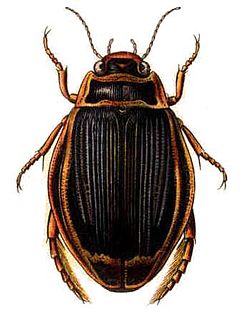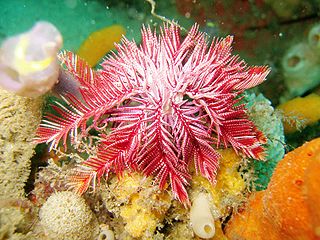
Biological systematics is the study of the diversification of living forms, both past and present, and the relationships among living things through time. Relationships are visualized as evolutionary trees. Phylogenies have two components: branching order and branch length. Phylogenetic trees of species and higher taxa are used to study the evolution of traits and the distribution of organisms (biogeography). Systematics, in other words, is used to understand the evolutionary history of life on Earth.

Graptolithina is a subclass of the class Pterobranchia, the members of which are known as graptolites. These organisms are colonial animals known chiefly as fossils from the Middle Cambrian through the Lower Carboniferous (Mississippian). A possible early graptolite, Chaunograptus, is known from the Middle Cambrian. One analysis suggests that the pterobranch Rhabdopleura represents extant graptolites. Studies on the tubarium of fossil and living graptolites showed similarities in the basic fusellar construction and it is considered that the group most probably evolved from a Rhabdopleura-like ancestor.

Spiral galaxies form a class of galaxy originally described by Edwin Hubble in his 1936 work The Realm of the Nebulae and, as such, form part of the Hubble sequence. Most spiral galaxies consist of a flat, rotating disk containing stars, gas and dust, and a central concentration of stars known as the bulge. These are often surrounded by a much fainter halo of stars, many of which reside in globular clusters.

The Adephaga, with more than 40,000 recorded species in 10 families, are a suborder of highly specialized beetles and the second-largest suborder of the order Coleoptera. Members of this suborder are collectively known as adephagans, and include ground beetles and a variety of aquatic beetles, such as predaceous diving beetles and whirligig beetles. Most of the species belong to the family Carabidae.

Brittle stars, serpent stars, or ophiuroids are echinoderms in the class Ophiuroidea closely related to starfish. They crawl across the sea floor using their flexible arms for locomotion. The ophiuroids generally have five long, slender, whip-like arms which may reach up to 60 cm (24 in) in length on the largest specimens. From New Latin ophiurus, from Ancient Greek ὄφις + οὐρά.
The Uropeltidae, also known commonly as the shieldtails or the shield-tailed snakes, are a family of primitive, nonvenomous, burrowing snakes native to peninsular India and Sri Lanka. The name is derived from the Greek words ura ('tail') and pelte ('shield'), indicating the presence of the large keratinous shield at the tip of the tail. Seven or eight genera are recognized, depending on whether Teretrurus rhodogaster is treated in its own genus or as part of Brachyophidium. The family comprises over 50 species. These snakes are not well known in terms of their diversity, biology, and natural history.

Disk-winged bats are a small group of bats of the family Thyropteridae and genus Thyroptera. They are found in Central and South America, usually in moist tropical rain forests. It is a very small family, consisting of a single genus with five extant and one fossil species.

Snipe eels are a family, Nemichthyidae, of eels that consists of nine species in three genera. They are pelagic fishes, found in every ocean, mostly at depths of 300–600 m but sometimes as deep as 4000 m. Depending on the species, adults may reach 1–2 m (39–79 in) in length, yet they weigh only 80-400 g. They are distinguished by their very slender jaws that separate toward the tips as the upper jaw curves upward. The jaws appear similar to the beak of the bird called the snipe. Snipe eels are oviparous, and the juveniles, called Leptocephali, do not resemble the adults but have oval, leaf-shaped and transparent bodies. Different species of snipe eel have different shapes, sizes and colors. The similarly named bobtail snipe eel is actually in a different family and represented by two species, the black Cyema atrum and the bright red Neocyema erythrosoma.
The Oegophiurida are an order of brittle stars, class Ophiuroidea.

Articulata are the only extant subclass of the class Crinoidea. The group includes "sea lilies" and "feather stars". The Articulata are differentiated from the extinct subclasses by their lack of an anal plate in the adult stage and the presence of an entoneural system.

The Ophiurida are an order of echinoderms within the class Ophiuroidea. It includes the vast majority of living brittle stars.

Basket stars are a taxon of brittle stars. They are treated as a suborder Euryalina or order Euryalida. Many of them have characteristic repeatedly branched arms. They generally live in deep sea habitats. However, they have been observed near 15 m or less in Plettenberg Bay, South Africa. In the wild they may live up to 35 years. They weigh up to 5 kilograms (11 lb). Like other echinoderms, basket stars lack blood and achieve gas exchange via their water vascular system.
Zeugophiurina is a suborder of primitive brittle stars with three extinct families. The family Ophiocanopidae with only one living genus and species, Ophiocanops fugiens has been placed here but recent studies have challenged this classification.
Ophiocanops fugiens is a living species in the brittle star family Ophiocanopidae. Though once considered to be the only one living species in this brittle star family, recent research has brought to light three specimens of Ophiocanops that differ substantially from O. fugiens. It has been regarded as the most primitive brittle star, close to Paleozoic forms, though other authors have disagreed with the view. Classification of O. fugiens is highly argued. Ophiocanops is usually placed in the order Oegophiurida or regarded as a genus incertae sedis or even given its own subclass Oegophiuridea. Some recent data suggest its relationship to the extant family Ophiomyxidae.
This glossary of botanical terms is a list of definitions of terms and concepts relevant to botany and plants in general. Terms of plant morphology are included here as well as at the more specific Glossary of plant morphology and Glossary of leaf morphology. For other related terms, see Glossary of phytopathology and List of Latin and Greek words commonly used in systematic names.

Patiria miniata, the bat star, sea bat, webbed star, or broad-disk star, is a species of sea star in the family Asterinidae. It typically has five arms, with the center disk of the animal being much wider than the stubby arms are in length. Although the bat star usually has five arms, it sometimes has as many as nine. Bat stars occur in many colors, including green, purple, red, orange, yellow and brown, either mottled or solid. The bat star gets its name from the webbing between its arms, which is said to resemble a bat's wings.
Biscoia is a genus of springtails in the family Hypogastruridae. There is at least one described species in Biscoia, B. sudpolaris.
Ecuadogastrura is a genus of springtails in the family Hypogastruridae. There is at least one described species in Ecuadogastrura, E. trinkleini.

Xenylla is a genus of springtails and allies in the family Hypogastruridae. There are at least 120 described species in Xenylla.
Astrobrachion constrictum is a basket star in the family Euryalidae. It is mostly found at depths of between 50 and 180 m, but around the coast of New Zealand it occurs in shallow waters, in association with the black coral Antipathella fiordensis.











